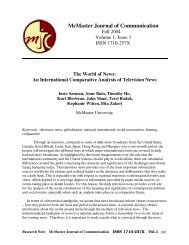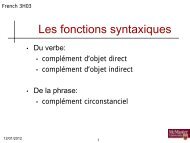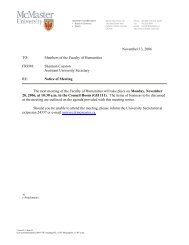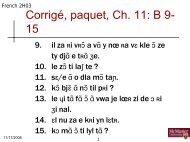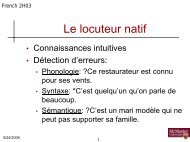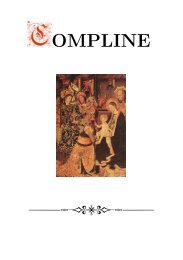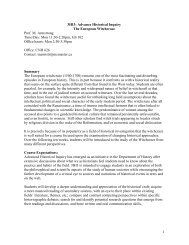The Syntax of Givenness Ivona Kucerová
The Syntax of Givenness Ivona Kucerová
The Syntax of Givenness Ivona Kucerová
You also want an ePaper? Increase the reach of your titles
YUMPU automatically turns print PDFs into web optimized ePapers that Google loves.
Chapter 1<br />
To Be Given<br />
Consider the Czech sentences in (1). 1,2<br />
(1) a. SVO: Chlapec našel lízátko.<br />
boy.Nom found lollipop.Acc<br />
b. OVS: Lízátko našel chlapec.<br />
lollipop.Acc found boy.Nom<br />
c. SOV: Chlapec lízátko NAŠEL.<br />
boy.Nom lollipop.Acc found<br />
d. OSV: LÍZÁtko chlapec našel.<br />
lollipop.Acc boy.Nom found<br />
<strong>The</strong> sentences in (1) describe a similar situation. In each <strong>of</strong> them the speaker asserts that<br />
there was a time interval in the past such that an event <strong>of</strong> finding took place in that interval.<br />
Furthermore, we learn that the event <strong>of</strong> finding had two participants (a finder and a findee)<br />
and we also learn who these participants were (some boy and a lollipop). <strong>The</strong> sentences in<br />
(1) nevertherless differ in their meaning and in the set <strong>of</strong> contexts in which they are felicitous.<br />
To see this, let’s first concentrate on the first two orders, i.e., the SVO and the OVS<br />
orders. Corresponding English translations <strong>of</strong> the Czech sentences are given in (2). 3<br />
1 Capital letters here and throughout the text stand for a contrastively stressed syllable.<br />
2 <strong>The</strong> four combinations given in (1) are the only combinations that can be used as declarative clauses. <strong>The</strong><br />
remaining permutations, given in (i) and (ii), are grammatical but only as questions. <strong>The</strong> following chapters<br />
will deal with declarative clauses only.<br />
(i)<br />
(ii)<br />
VSO: Našel chlapec lízátko?<br />
found boy.Nom lollipop.Acc<br />
‘Did the boy found the lollipop?’<br />
VOS: Našel lízátko chlapec?<br />
found lollipop.Acc boy.Nom<br />
‘Was it the lollipop what the boy found?’<br />
3 <strong>The</strong> hash sign # stands for an utterance that is not felicitous in the given context. In this particular case,<br />
it stands for an infelicitous translation.<br />
6







